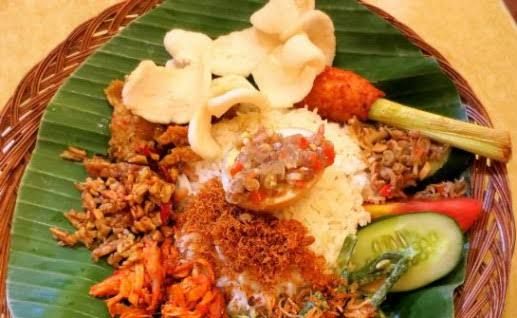
Rice was the staple food in the Indonesian diet, accounting for more than half of the calories in the average diet, and the source of livelihood for about 20 million households, or about 100 million people, in the late 1980s. Rice cultivation covered a total of around 10 million hectares throughout the archipelago, primarily on sawah.[1] The supply and control of water is crucial to the productivity of rice land, especially when planted with high-yield seed varieties. In 1987 irrigated sawah covered 58 percent of the total cultivated area, rainfed sawah accounted for 20 percent, and ladang, or dryland cultivation, together with swamp or tidal cultivation covered the remaining 22 percent of rice cropland.
Rice is a staple food for all classes in contemporary Indonesia,[2][3] and it holds the central place in Indonesian culture and Indonesian cuisine: it shapes the landscape; is sold at markets; and is served in most meals both as a savoury and a sweet food. The importance of rice in Indonesian culture is demonstrated through the reverence of Dewi Sri, the rice goddess of ancient Java and Bali. Traditionally the agricultural cycles linked to rice cultivations were celebrated through rituals, such as Sundanese Seren Taun rice harvest festival. In Bali the traditional subak irrigation management was created to ensure the water supplies for rice paddies, managed by priest and created around "water temples".
Rice is most often eaten as plain rice with just a few protein and vegetable dishes as side dishes. It is also served, however, as nasi uduk (rice cooked in coconut milk), nasi kuning (rice cooked with coconut milk and turmeric), ketupat (rice steamed in woven packets of coconut fronds), lontong (rice steamed in banana leaves), intip or rengginang (rice crackers), desserts, vermicelli, noodles, arak beras (rice wine), and nasi goreng (fried rice).[4] Nasi goreng is omnipresent in Indonesia and considered as national dish.[5]
Evidence of wild rice on the island of Sulawesi dates from 3000 BC. Evidence for the earliest cultivation, however, comes from eighth century stone inscriptions from the central island of Java, which show kings levied taxes in rice. The images of rice cultivation, rice barn, and mouse pest infesting a rice field is evident in Karmawibhangga bas-reliefs of Borobudur. Divisions of labour between men, women, and animals that are still in place in Indonesian rice cultivation, were carved into relief friezes on the ninth century Prambanan temples in Central Java: a water buffalo attached to a plough; women planting seedlings and pounding grain; and a man carrying sheaves of rice on each end of a pole across his shoulders (pikulan). In the sixteenth century, Europeans visiting the Indonesian islands saw rice as a new prestige food served to the aristocracy during ceremonies and feasts.[3]